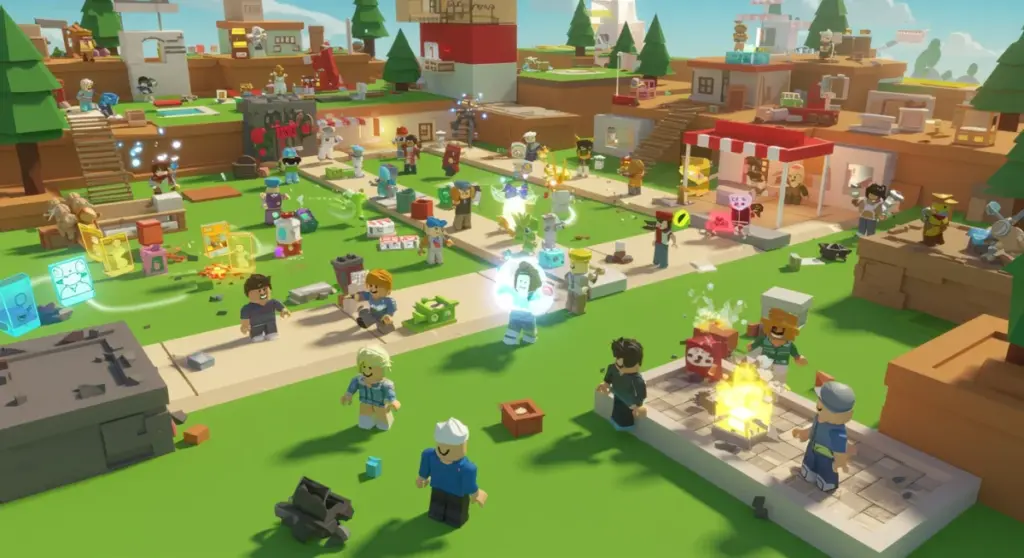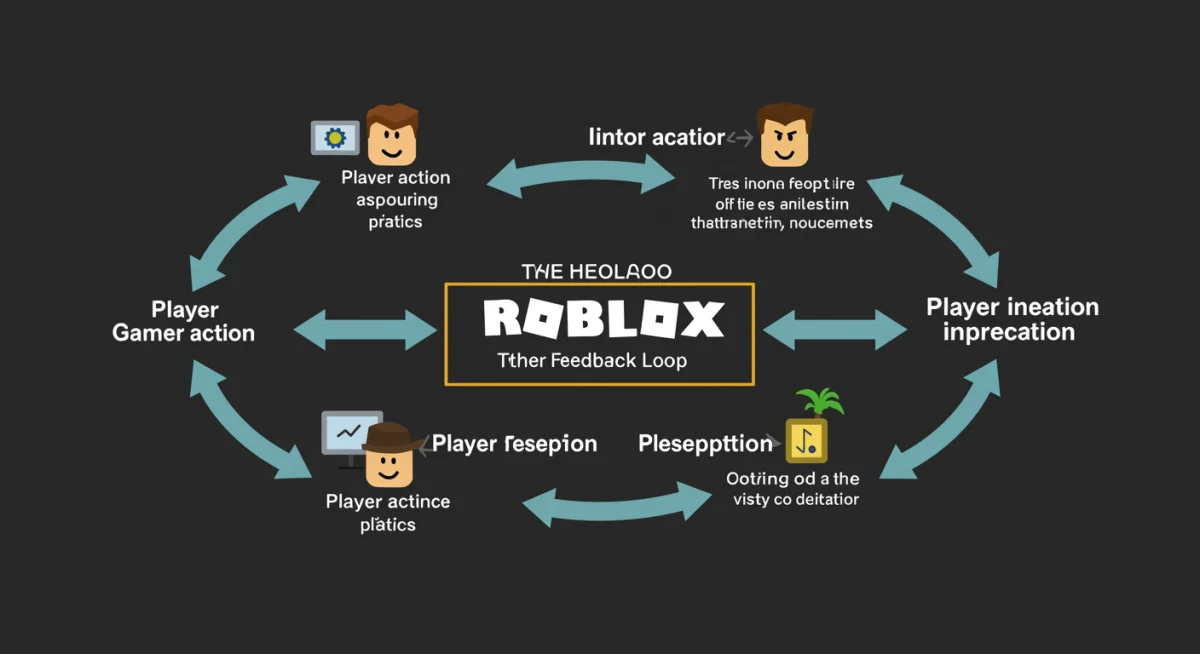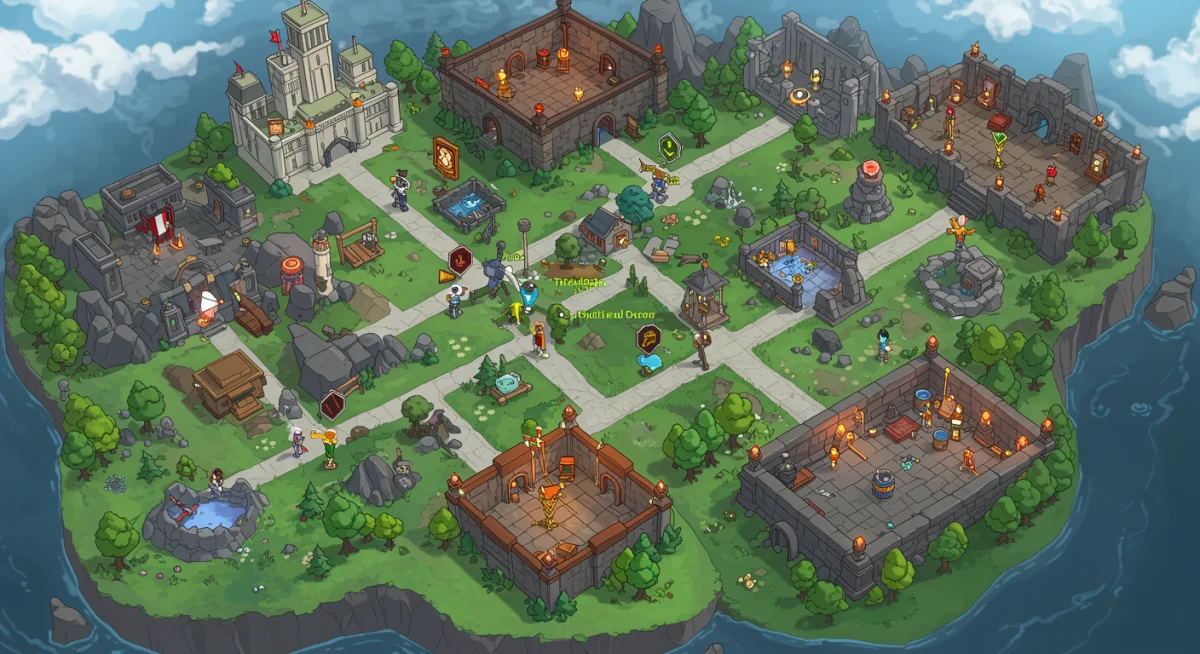Roblox Game Design Principles: Create Engaging Experiences

Anúncios
Mastering Roblox Game Design Principles is essential for developers seeking to build captivating and successful experiences that resonate deeply with a broad player base, ensuring sustained engagement and enjoyment.
Are you looking to create a Roblox game that truly stands out, one that players not only enjoy but keep coming back to? Understanding Roblox Game Design Principles is the cornerstone of building engaging experiences that captivate audiences and foster a loyal community. It’s not just about coding; it’s about crafting worlds and interactions that resonate with players on a deeper level.
understanding the roblox ecosystem and player psychology
Before diving into the specifics of game mechanics, it’s crucial to grasp the unique environment of Roblox and the psychology of its diverse player base. Roblox is more than just a platform; it’s a social hub, a creative outlet, and a universe of endless possibilities. Players, ranging from young children to teenagers and even adults, come to Roblox seeking different things: adventure, social interaction, creativity, competition, or simply a place to relax and unwind. Recognizing these varied motivations is the first step in designing a game that truly connects.
The Roblox ecosystem thrives on user-generated content, meaning players expect a certain level of innovation and originality, but also familiarity. They are accustomed to certain controls and interfaces, so deviating too much without clear guidance can be jarring. Understanding player psychology involves anticipating their desires, identifying their pain points, and designing experiences that offer both challenge and reward. It’s about creating a compelling reason for them to explore, interact, and return.
the power of community and social interaction
Roblox is inherently social. Many players seek out games where they can interact with friends or make new ones. Incorporating social features isn’t just a bonus; it’s often a core expectation. This can range from simple chat functions to complex cooperative or competitive modes.
- Multiplayer Focus: Design core loops that encourage group play and interaction.
- Communication Tools: Implement intuitive chat, emotes, and social gestures.
- Shared Experiences: Create moments where players can collaborate or compete together.
- Community Building: Foster a sense of belonging through in-game groups or leaderboards.
Ultimately, a deep understanding of the Roblox player base—their motivations, expectations, and social inclinations—forms the bedrock of effective game design. This insight allows developers to tailor experiences that are not only fun but also deeply resonant within the platform’s unique context, ensuring sustained engagement and fostering a vibrant community around their creations.
core mechanics: building a strong foundation
The heart of any engaging Roblox game lies in its core mechanics. These are the fundamental rules, actions, and systems that govern how players interact with your game world. A well-designed core mechanic is intuitive, rewarding, and offers depth, allowing for both immediate enjoyment and long-term mastery. Think about what makes your game unique and how players will spend most of their time. Is it exploring a vast world, battling enemies, solving puzzles, or building elaborate structures? Whatever it is, ensure these actions feel good to perform and provide clear feedback.
Consider the simplicity of games like "Adopt Me!" where the core mechanic revolves around adopting and caring for pets, or "Jailbreak," which focuses on escaping prison and exploring a city. Both have clear, understandable core loops that are easy to pick up but offer enough variety to keep players engaged. A strong foundation means that even when new features are added, they enhance, rather than detract from, the central player experience. It’s about clarity of purpose and execution.
iterative design and player feedback
Developing robust core mechanics is not a one-time process; it’s iterative. Launching an alpha or beta version and actively soliciting player feedback is invaluable. Players often reveal unexpected issues or suggest improvements that can elevate your game significantly. Pay attention to how players naturally interact with your mechanics versus how you intended them to. This feedback loop is essential for refinement.


- Early Testing: Get your game into players’ hands as soon as possible.
- Listen Actively: Pay attention to both explicit feedback and observed player behavior.
- Iterate Quickly: Make small, frequent adjustments based on feedback.
- Communicate Changes: Let players know their input is valued and acted upon.
By focusing on strong, intuitive core mechanics and embracing an iterative design process driven by player feedback, developers can ensure their Roblox game has a solid foundation for long-term success and player enjoyment. This commitment to refinement is what transforms a good idea into a truly great game.
level design and environmental storytelling
Level design on Roblox is more than just arranging assets; it’s about crafting immersive environments that guide players, tell a story, and enhance gameplay. A well-designed level feels cohesive and purposeful, leading players through different experiences while maintaining a sense of discovery. Think about the flow of your game: how do players move from one area to another? Are there clear objectives, or is exploration encouraged? The visual elements, sound design, and interactive objects all contribute to the overall atmosphere and player experience.
Effective environmental storytelling uses the game world itself to convey narrative and context without relying heavily on text or cutscenes. This could be subtle clues in the architecture, worn-out textures suggesting a long history, or strategically placed items that hint at a larger lore. Such design choices make the world feel lived-in and encourage players to delve deeper, fostering a stronger connection to the game’s universe. It’s about showing, not just telling, and allowing players to piece together the narrative themselves.
creating engaging spaces and challenges
Each area within your game should offer unique challenges or opportunities. Avoid monotonous repetition. Introduce new mechanics, enemy types, or puzzle elements as players progress. This keeps the experience fresh and prevents players from becoming bored. Consider how different environmental features can be integrated into gameplay.
- Varied Biomes: Introduce distinct visual and gameplay zones.
- Strategic Obstacles: Place hazards and puzzles that require skill or thought.
- Hidden Secrets: Encourage exploration with collectibles or secret paths.
- Clear Pathways: Guide players intuitively while allowing for freedom.
Ultimately, thoughtful level design and environmental storytelling are powerful tools for creating immersive Roblox experiences. They transform a simple play space into a vibrant world, drawing players in and keeping them invested in the unfolding journey. A well-crafted environment is a game’s silent narrator, enriching every interaction.
player progression and reward systems
One of the most effective Roblox Game Design Principles for long-term engagement is a robust player progression and reward system. Players inherently seek growth and accomplishment. Whether it’s leveling up, unlocking new abilities, earning rare items, or climbing leaderboards, clear progression paths provide a sense of purpose and motivate continued play. The key is to make progress feel meaningful and the rewards genuinely desirable. This involves balancing effort with reward, ensuring that challenges are appropriate and achievements feel earned.
Rewards don’t always have to be tangible items; they can also be social recognition, access to exclusive areas, or new cosmetic options. The psychology behind reward systems is complex, leveraging principles of variable reinforcement to keep players hooked. A well-designed system provides a steady stream of short-term goals and rewards, interspersed with more significant long-term aspirations, keeping the player invested in their journey within your game world. It’s about creating a continuous loop of goal-setting, achievement, and anticipation.
types of progression and their impact
Different types of progression appeal to different player motivations. Combining several methods can create a richer, more engaging experience. For example, a game might have character-level progression for power, a reputation system for social standing, and a collection system for completionists.


- Skill-Based Progression: Players improve through practice and mastery of mechanics.
- Unlocking Content: New areas, modes, or features become available over time.
- Cosmetic Rewards: Skins, accessories, or unique appearances allow for personalization.
- Resource Accumulation: Gathering in-game currency or materials for crafting.
By carefully crafting diverse progression and reward systems, developers can cater to a wide range of player preferences, ensuring that there’s always something new to strive for. This continuous cycle of challenge and reward is fundamental to keeping players engaged and fostering a thriving game economy within Roblox.
monetization strategies and ethical design
Monetization is an integral part of creating a successful Roblox game, allowing developers to be rewarded for their creativity and effort. However, it’s crucial to approach monetization with ethical considerations and design principles that enhance, rather than detract from, the player experience. The goal is to offer value through purchases, not to exploit players or create pay-to-win scenarios that alienate the community. Transparency and fairness are paramount when designing your in-game economy.
Effective monetization often involves offering cosmetic items, convenience features, or unique experiences that don’t directly impact gameplay balance. For instance, players might purchase unique pet skins, faster travel options, or access to private servers. When players feel they are getting genuine value for their Robux, they are more likely to support the game. Conversely, aggressive or predatory monetization tactics can quickly lead to player dissatisfaction and a decline in engagement. It’s a delicate balance that requires thoughtful implementation and continuous monitoring.
balancing player value and developer revenue
Finding the sweet spot between generating revenue and providing value to players is key. This often involves offering a variety of purchase options at different price points, catering to casual spenders and dedicated enthusiasts alike. Always consider how a purchase impacts the player’s enjoyment and their perception of fairness within the game world.
- Cosmetic Items: Outfits, accessories, emotes that personalize the player’s avatar.
- Time Savers: Gamepasses that accelerate progress without conferring unfair advantages.
- Exclusive Content: Access to special areas or unique experiences that are not essential but add to enjoyment.
- Developer Products: Consumable items that offer temporary boosts or resources.
By adhering to ethical design principles and focusing on providing genuine value, developers can implement monetization strategies that are both profitable and respectful of their player base. This approach ensures long-term success and maintains the positive reputation of the game within the Roblox community.
optimizing performance and accessibility
Two often-overlooked yet critical Roblox Game Design Principles are performance optimization and accessibility. A visually stunning game with innovative mechanics will fail to engage players if it runs poorly or is difficult for certain individuals to access. Roblox players use a wide range of devices, from high-end PCs to older mobile phones. Ensuring your game runs smoothly across this spectrum is vital for a broad audience. Lag, crashes, or slow loading times are immediate deterrents that can cause players to leave and not return.
Accessibility, on the other hand, means designing your game so that as many people as possible can enjoy it, regardless of their physical or cognitive abilities. This includes considering players with visual impairments, hearing difficulties, motor skill challenges, or cognitive differences. Simple adjustments can make a huge difference in opening your game up to a wider, more inclusive audience. It’s about empathy in design, ensuring that the experience is enjoyable for everyone.
strategies for a broad player base
Optimizing performance involves efficient scripting, judicious use of assets, and careful management of server resources. Accessibility can be addressed through customizable controls, clear UI/UX design, and options for visual or auditory adjustments.
- Efficient Scripting: Write clean, optimized code to reduce lag.
- Asset Management: Use appropriate texture sizes and mesh complexity.
- Scalable Graphics: Offer graphics options for lower-end devices.
- Customizable Controls: Allow players to remap keys or adjust sensitivity.
- Clear UI: Use legible fonts, high contrast, and intuitive navigation.
Prioritizing performance and accessibility is not just good practice; it’s a strategic advantage. By ensuring your Roblox game is playable and enjoyable for the widest possible audience, you significantly increase its potential for success and foster a more inclusive community. These principles are fundamental to creating truly engaging and enduring experiences.
future-proofing your roblox game and continuous engagement
The Roblox platform is constantly evolving, and so too should your game. Future-proofing your Roblox game involves designing with scalability in mind, anticipating new features or trends, and maintaining a commitment to continuous engagement. A successful game isn’t just launched; it’s nurtured and grown over time. This means planning for regular updates, seasonal events, and new content that keeps the player base excited and gives them reasons to return. Stagnation is the enemy of long-term success in the dynamic world of Roblox.
Continuous engagement goes beyond just adding new content. It involves active community management, listening to player feedback, and fostering a sense of ownership among your audience. Hosting events, running contests, and interacting with players on social media or dedicated forums can build a strong, loyal community. When players feel heard and valued, they become advocates for your game, contributing to its longevity and growth. It’s about building a living, breathing experience that adapts and grows with its community.
strategies for sustained growth and player retention
To ensure your game remains relevant and engaging, a proactive approach to updates and community interaction is essential. This includes not only fixing bugs but also introducing meaningful new content that aligns with player expectations and evolving trends.
- Regular Updates: Introduce new features, items, or game modes consistently.
- Seasonal Events: Create themed events tied to holidays or in-game lore.
- Community Feedback Loops: Implement systems for players to suggest ideas and report issues.
- Developer Transparency: Communicate future plans and changes openly with the community.
By embracing a mindset of continuous improvement and active community engagement, developers can future-proof their Roblox games, ensuring they remain vibrant, relevant, and beloved by players for years to come. This long-term vision is what truly defines successful game design on the platform.
| Key Principle | Brief Description |
|---|---|
| Player Psychology | Understand diverse player motivations and social inclinations for deep engagement. |
| Core Mechanics | Design intuitive, rewarding, and deep fundamental actions with iterative feedback. |
| Progression Systems | Implement meaningful growth paths and desirable rewards for long-term player retention. |
| Ethical Monetization | Offer value-driven purchases that enhance experience without exploiting players. |
frequently asked questions about roblox game design
The most important principles include understanding player psychology, designing intuitive core mechanics, implementing clear progression systems, and fostering social interaction. These elements ensure a game is both fun and provides a sense of accomplishment, encouraging players to return consistently.
To boost engagement, focus on iterative design based on player feedback, introduce varied challenges, and provide meaningful rewards. Incorporate social features, ensure smooth performance across devices, and regularly update content to keep the experience fresh and exciting for your community.
Monetization is key for developer sustainability. It should be approached ethically, offering value through cosmetic items, time-savers, or unique experiences rather than pay-to-win mechanics. Transparency and fairness are crucial to maintain player trust and foster a healthy game economy.
Effective level design guides players, tells stories through the environment, and presents varied challenges. It creates immersive spaces with clear pathways, hidden secrets, and distinct zones, enhancing exploration and preventing monotony, which ultimately deepens player immersion.
Performance optimization ensures smooth gameplay across diverse devices, preventing lag and crashes that deter players. Accessibility makes the game enjoyable for individuals with various abilities, broadening your audience and fostering an inclusive community, leading to wider adoption and success.
conclusion
Ultimately, mastering Roblox Game Design Principles is a continuous journey of learning, adapting, and innovating. By prioritizing player psychology, crafting compelling core mechanics, designing immersive levels, implementing robust progression systems, and approaching monetization ethically, developers can create experiences that not only attract but also retain a dedicated player base. The most successful Roblox games are those that evolve with their communities, offering fresh content, fostering social interaction, and ensuring a smooth, accessible experience for everyone. Embrace these principles, and you’ll be well on your way to creating the next beloved Roblox sensation.





